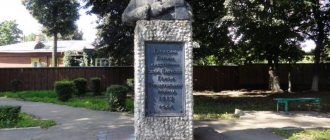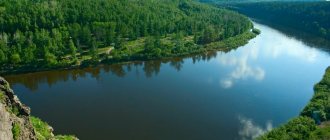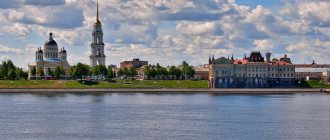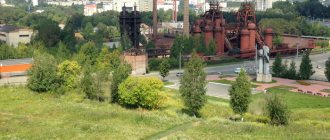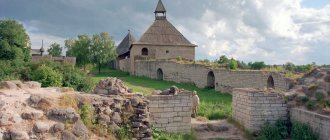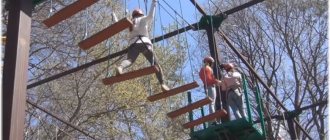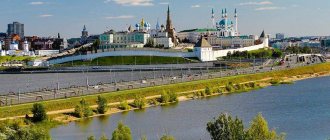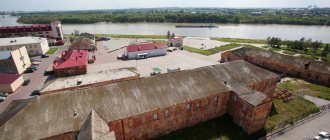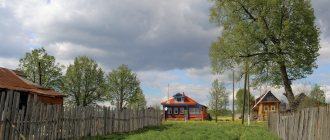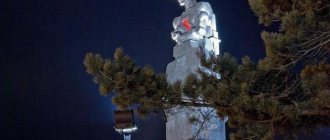Kursk: brief information
From the capital of Russia to this charming town is about 500 km. The settlement has a rich history and many different monuments. Kursk is located in a picturesque place on the Seim River. Today its population exceeds 400 thousand people. There are no problems with tourist infrastructure. There are also various entertainment centers, as well as shops and boutiques for every taste. The vast majority of tourists coming to the city of Kursk are more interested in sights, because you can have a delicious meal or go to the cinema in your native locality. There should be no problems with the cultural program. The city has many museums to suit every taste; there are unique architectural monuments, as well as modern sculptural compositions. Don’t forget to take a camera and a spare battery with you on your trip; there are plenty of places to take pictures here. You can go to Kursk at any time of the year, the climate is mild, and the city landscapes look equally good under the snow cover and in the riot of vegetation.
A little history
The first mentions of this city in historical documents date back to 1032. Already at that time it was quite large and famous, as it was located on a significant trade route. According to one version, the settlement was founded by the peoples of Scandinavia. Eminent historians still argue about the origin of the city’s name. There are two versions. If you believe the first, then the settlement was named after the river (“Kur”) on which it stands. Opponents of this theory say that the city was named after the partridges that live in its surroundings. These birds are also depicted on the modern coat of arms of the city. In 1095 the Kursk Appanage Principality was founded. In the sixteenth century, a reliable fortress was erected here, and for two centuries the city was a significant military-strategic object for the entire Kievan Rus. But already in the eighteenth century, Tatar-Mongol troops heavily plundered and destroyed this settlement. However, it was restored and played a significant role in the Great Patriotic War. Many monuments in Kursk are dedicated specifically to the Battle of Kursk, which significantly influenced the course of the war. Nowadays, the settlement proudly bears the title of hero city. This settlement is also included in the list of the cleanest and most well-groomed cities in Russia.
Project on the topic “Monuments of the Kursk Bulge”
Slide 1
Monuments of the Northern face of the Kursk Bulge Completed by: 9th grade and first grade teacher. Tatarenkova L.P. 2017-2018 academic year
Slide 2
Monument to the “Heroes-Sappers” The first monument on the Northern face of the Kursk Bulge to the “Heroes-Sappers” was built by decision of the Military Council of the Central Front at an altitude of 257.1 m northeast of Ponyri. At first it was a brick obelisk in the form of a truncated pyramid 5 m high. The opening of the obelisk took place at the end of July 1943. In 1967, the obelisk was reconstructed into a monument
Slide 3
Mound of Glory “To Signal Soldiers” in the village of Ponyri In the northern part of the outskirts of the village of Ponyri, a Mound of Glory was erected in honor of signal soldiers of the Central Front who died during the battles on the Kursk Bulge in the summer of 1943. Light steps flow upward along a high earthen embankment; on the pedestal there is a granite stone with the inscription: “To the signalmen. 1941-1945"; Below is a quatrain from students: “There is no stronger contact than the will of a soldier, And that’s why every time, When the life of a signalman in battle was cut short, The connection was never broken.” There are flexible birch trees around.
Slide 4
On the station square of the village. Ponyri is a military cemetery, previously crowned with a sculpture of a victorious warrior. Here those who, at the cost of their own lives, blocked the Nazis’ path to Kursk sleep in eternal sleep. This monument is a copy of the monument to the victorious soldier of the Soviet Army, installed in Treptow Park in Berlin. Everyone who comes to the Ponyri station visits this sacred place and honors the memory of the warrior-heroes of the Russian land with a minute of silence with their heads naked. At this time, the monument is located on the territory of the Ponyrovsky Museum of the Battle of Kursk.
Slide 5
Memorial complex “To the Heroes of the Northern Face of the Kursk Bulge” (Ponyri) On the station square, near the newly built beautiful railway station, completely destroyed during the war, on July 18, 1993, a Memorial was opened for the 50th anniversary of the Battle of Kursk. Authors of the complex: architect S.G. Chernov, sculptor I.A. Minin, artist V.M. Bartenev. The memorial was built in honor of Soviet soldiers who heroically fought as part of the Central Front in the Ponyri region in July 1943. The memorial complex, built on the station square, now Victory Square, includes: the monumental sculpture “For Our Soviet Motherland”, the Eternal Flame of Glory, a voluminous decorative wall depicting the Order of the Patriotic War against the backdrop of a guards ribbon, as well as a fraternal cemetery where more than thousands of soldiers who died on the territory of the Ponyrovsky district on the northern front of the Kursk Bulge.
Slide 6
At the entrance to the village of Ponyri there is a monument to tank crews. It is erected in honor of the tank crews of the Second Tank Army, the 9th and 19th Tank Corps. The tank warriors fought to the death and stopped the enemy at Ponyri. They completed their arduous journey in Berlin. 150 orders adorned the battle banners of the army formations. For courage and bravery, 103,350 army soldiers were awarded orders and medals.
Slide 7
Mass grave of soldiers of the 307th Infantry Division in the village of Ponyri. Mass grave of soldiers of the 307th Infantry Division of the 13th Army, who died in July 1943 in the battles for the liberation of the village of Ponyri during the Battle of Kursk. Heroes of the Soviet Union Alexander Petrovich Zhukov and Nikolai Dmitrievich Kozyakov are buried in this mass grave.
Slide 8
In honor of the 30th anniversary of the Victory, a monument to the soldiers of the 140th SD was erected on the northern outskirts of Teply on the site of bloody battles. The author of the project is Voronkov G.M., the customer of the project is Garkavenko L.M. The grand opening of the monument took place on May 9, 1975. In 1995, the monument was lined with marble tiles. The words are cast on it: “The Siberian Novgorod-Severskaya, Order of Lenin, twice Red Banner, Order of Suvorov and Kutuzov rifle division, July 7-16, 1943, at the Samodurovka-Teploye-Pogoreltsy line, stood to the death so that you may live.” The author of the project and construction manager is the former head of the engineering service of the 96th Chita Regiment, Honored Builder of the RSFSR Gleb Mikhailovich Voronkov. The sketch of the sign was made by Moscow architect L.D. Fishbein.
Slide 9
Mass grave of 502 soldiers near the village of Vtorye Ponyri. Mass grave of soldiers who died in battles for their homeland against the Nazi invaders on the Kursk Bulge. The monument (sculpture “Soldier with a banner in his left hand and a machine gun in his right”) was erected in 1951. Author – N.I. Boleutsky.
Slide 10
Monument "Teplovsky Heights" The monument is made in the shape of an anti-tank mine. The monument is a three-level observation deck. The upper level is located at bird's eye height (17 meters). From here you can see the battle arena. The Teplov Heights were the key to Kursk for the Nazis, but the Nazis failed to get this key. The USSR flag flutters above the monument, and the dates of each day of the Battle of Kursk are posted on the railings of the observation deck. The soldiers and officers fought to the death, but did not let the enemy into the city.
Slide 11
Monument to the “Heroes-Artillerymen” On the main facade of the pedestal there is an inscription carved: “Eternal glory to the Heroes-artillerymen who fell on July 7-12, 1943 in battles with the Nazi invaders.”
Slide 12
Monument - obelisk Mass grave of soldiers of the Soviet Army who died during the Great Patriotic War (1941-1945) is located in the center of the village of Olkhovatka, 18 kilometers from the village of Ponyri.
Slide 13
From the sculpture "Angel of Peace". "Angel of Peace" perpetuates the feat of Soviet soldiers who gave their lives for the Victory.
Slide 14
Mound of Glory - to the guardsmen of the 6th Red Army Order of Lenin Rifle Rivne Order of Suvorov Division At the foot of the Mound of Glory there are slabs on which the message “Stop, passer-by” is written! Bow down to this earth! Here, during the menacing years of the Great Patriotic War, warriors – guardsmen of the 6th Red Army Order of Lenin Rifle Rivne Order of Suvorov Division fought heroically.”
We remember the war...
One of the symbols of Kursk is the Kursk Bulge memorial. The open-air museum stretches for almost a kilometer along Victory Boulevard. It is impossible not to notice the complex. It includes the Triumphal Arch, the monument to Zhukov, and the Church of St. George the Victorious. Here you can also see a sculpture dedicated to the victims of the shootings, the figure of an unknown soldier and the sign of the city of military glory. There is also its own alley of military equipment. The sights of Kursk related to the Second World War do not end there. The local Officers' House houses a museum of the Battle of Kursk. Here you can learn more about how the battle took place, see awards and personal belongings of the fighters.
Museum-Reserve "Prokhorovskoye Field"
State Military Historical Museum-Reserve…
Prokhorovsky district
The Prokhorovskoye Field Museum-Reserve was opened in May 1995. Military graves, monuments, sculptures, and military equipment on its territory tell the history of the tank battle better than any words. At the site where the fiercest battles took place on July 12, a 59-meter-high belfry was installed. In memory of the three battlefields of Russia - Kulikovo, Borodino and Prokhorovsky - its bell rings three times an hour.
Not far from the belfry there is a museum “The Third Military Field of Russia”. His collection includes soldiers' letters, documents, photographs and personal belongings of soldiers. On the interactive map you can see how the battle went. Also on the territory there are trenches, dugouts and shelters for equipment, some of which you can go down into.
The museum-reserve houses Russia's first tankodrome - an open area for displaying military vehicles. Similar testing grounds exist only in England and the Czech Republic. The tankodrome fleet has 12 pieces of equipment, including an armored personnel carrier, infantry and airborne combat vehicles, and an armored vehicle.
Let's find out the story
Kursk museums will delight tourists with exhibitions for every taste. There is also a planetarium in the city, and you can also see the trams. But it still makes sense to start your acquaintance with the city with the Museum of Local Lore and the Military History Museum. In the first one you can see original pieces of furniture and household items, original documents and works of art. To make it easier to view the collections, they are divided into three categories. These are our days and the USSR, the ancient history of the region, as well as an overview of natural resources. The scale is impressive - the total area of exhibits is 1200 hectares, the number of valuable items in the collection is more than 170 thousand. This is an incredible amount for a local history museum.
Unique archaeological museum
The Kursk Archaeological Museum is an unusual entity for Russia. The thing is that there is not only an exposition for visitors to see here. The collection is regularly updated. The thing is that the museum specializes exclusively in conducting excavations in a specific region and studying the valuable objects found. At the same time, the museum’s activities are aimed primarily at finding and preserving architectural monuments. A variety of objects are explored - ancient settlements and sites, mounds and burials of various periods. The museum is located in the house of the merchant Khloponin, which is otherwise called the Romodanovsky Chambers. This building is an architectural monument and looks great even today thanks to regular restoration work.
Cultural life
The city of Kursk is known not only as a place of great battles, but also as a modern cultural center. A must-visit object is the art gallery named after. A. Deineki. Today you can see about 8.5 thousand exhibits here. The collection presents outstanding examples of European sculpture, painting and graphics. You can see folk art items here. In Kursk you can get to know the theater arts better. The Pushkin Drama Theater is open for adults. For children and teenagers - theater for young spectators or puppets. The city has four large parks. On holidays, folk festivals and various entertainment programs are held here.
Museum-diorama “Arc of Fire. Kursk direction"
Belgorod State Historical and Art Museum…
Belgorod
The diorama museum was opened in Belgorod in 1987. The picturesque canvas of the diorama with an area of 1005 square meters became one of the largest works of art dedicated to the Great Patriotic War. The painting was created by battle painters from the Mitrofan Grekov Studio. The creative team was led by Nikolai But.
Veterans of the Battle of Kursk and their relatives donated front-line relics to the museum - documents, awards, army newspapers and personal belongings of soldiers. Today they form the basis of the collection. Paintings and graphic works dedicated to the Battle of Kursk are also stored here. Military equipment is displayed on the street.
The museum regularly hosts thematic interactive quizzes for children and teenagers, and researchers give lectures on the military history of the region. In the Liberation Hall of Belgorod there is an electronic Book of Memory: museum staff help visitors find information about the award, military path or burial place of participants in the Great Patriotic War.
Other museums in Kursk
There is also an exhibition in this city dedicated to the exploits of minor residents of these places during the Second World War. The museum is called “Young Defenders of the Motherland.” Here you can learn about the exploits of very young children in difficult times, as well as many interesting stories related to their everyday life. It is difficult to list all the attractions of Kursk; there are only 13 museums in this city. In addition to those described above, there are: literary, zoological, automobile and even its own cosmonautics museum. Kursk also has its own planetarium. In addition to the Deineka art gallery, the city has a gallery of modern art and an exhibition hall of the Art Fund. As in any other large city, temporary exhibitions and various fairs are held here periodically, where interesting items can not only be viewed, but also purchased.
Railway station building
Address: Kursk, Station Square, 1 Coordinates: 51.749918, 36.227577
Built in 1946-1951 according to the design of the architect I.G. Yaveina. The station was opened to passengers on August 12, 1952. On the facade of the station building, memorial plaques are installed in honor of the military feats of military railway workers and the staff of the Kursk station during the days of the battles on the Arc of Fire in the summer of 1943. In the station premises, the design of one of the halls is dedicated to the victory of Soviet troops in the Battle of Kursk. It was intended as a monument to the heroes of the Battle of Kursk.
Kursk religious
Many of the sights of Kursk, photos with descriptions of which you can see, are visible from an impressive distance. We are, of course, talking about majestic churches, of which there are 33 in this city today. One of the most original buildings in this category is the Catholic Church. It is located on Marata Street and has been in operation since 1892. Not everyone knows that Kazimir Malevich once lived in this city, before he was yet world famous. The artist loved to visit this church, and also restored the icons in it. The oldest Orthodox church is located in the Trinity Monastery. The temple was built in 1695 and consecrated in honor of the Life-Giving Trinity. From an architectural point of view, the following are of interest: the Temple of the Holy Royal Passion-Bearers, the Temple of the Great Martyr Panteleimon and the Temple of the Archangel Michael.
Shopping arcades of merchant Filimonov
Address: Kursk region, Rylsk, pl. Sovetskaya, 7 Coordinates: 51.572493, 34.686656
In 1798, Ivan von Filimonov acquired a plot of land, and at the same time a plan was drawn up for the construction of stone shopping arcades and a large three-story Public House with columns, on the roof of which stood an observation tower. The construction of the complex took a long time and with some changes in the appearance of the three-story building.
After the construction of the Public House, the Filimonovs handed it over to the city. It housed: the City Duma, the Government, a school, a club and a library.
Shopping arcades, finally completed by the heirs of Ivan Fedotovich von Filimonov, decorate Rylsk to this day. At the corner stands a rotunda with two bays of windows two stories high. The facade is framed by columns, the upper tier is decorated with segmental windows. The domed roof ends in a small drum at the top, and the entire outer part of the rotunda looks like a trading weight. A walking gallery with arched openings stretches from the rotunda. The first semi-basement floor is decorated with segmental windows; Under the rotunda there are deep cellars. The northern wing of the shopping arcade, destroyed during the war and dismantled in the 1960s, also looked great.
Partially this complex has survived to this day.
Interesting examples of church architecture
Against the backdrop of modern business centers, ancient temples look solemn and majestic. Such development is typical for many settlements in our country, but local architecture still deserves attention. Kursk is rich in churches, and in its surroundings there are several ancient monasteries. It is definitely worth visiting the Sergius-Kazan Cathedral, located on Maxim Gorky Street. In terms of its decoration, it is not inferior to the churches of Moscow, it operates today, and it is easy to get to services here. The Znamensky Monastery has also survived to this day in good condition. Some of the buildings are not used for their intended purpose; in different years they housed both a factory and a warehouse. But today part of the monastery has been restored and is functioning. Speaking about the sights of Kursk, one cannot ignore the Church of the Resurrection of Christ. This is a relatively small red brick building with rich interior decoration.
Memorial in honor of the heroes of the Battle of Kursk
Memorial "In honor of the heroes of the Battle of Kursk"
Yakovlevsky district
Not far from the village of Yakovlevo, Belgorod Region, there is a memorial “In honor of the heroes of the Battle of Kursk,” a tribute to the memory of unknown soldiers. In 1973, the Eternal Flame was lit here. He was brought on an armored personnel carrier from Mamayev Kurgan in Volgograd by Hero of the Soviet Union, former pilot Nikita Kononenko.
On the territory of the memorial there is a stele and the Hall of Military Glory. There are mass graves nearby: more than 1,200 soldiers and officers are buried in them. In the center there is a monument to the Soviet soldier. In the village of Yakovlevo, a monument to the mortar guards was erected - the legendary Katyusha.
Monuments of Kursk
While walking around an unfamiliar city, you can see a lot of unusual and interesting things. Be sure to visit Kursk! Sights, photos of which will decorate your personal album, can be found here at every step. The most famous monument of the city is “Antonovka”.
This is a giant apple, with which for some reason all newlyweds take pictures. One of the newest monuments in the city is very popular among residents and guests of the city. The “date” sculpture depicts a guy breaking through a wall with a bouquet of flowers. Not everyone likes this composition; many call it tasteless and even ugly. However, you should still look at this miracle with your own eyes. The monuments of the city of Kursk are ideal for photo sessions. A striking example of this is the sculpture of Lieutenant Rzhevsky and the governor’s carriage. You'll want to sit on the bronze benches or even climb on a horse for a good photo. You can see how in some places the metal has been polished by tourists and local passers-by who love original photographs. The monument to Sviridov is also worth a visit.
Archive number No. 31 (981) dated July 30, 2013 - News
THIS IS INTERESTING
Monuments are a kind of indicator of the character of a city - they tell not only its history, but also convey the modern spirit. Let us note right away that we do not have original monuments such as “Honest Traffic Cop” in Belgorod, “Kitten from Lizyukov Street” in Voronezh, “Yoshkin the Cat” in Yoshkar-Ola, “Plumber” in Yekaterinburg or “Official and Entrepreneur” in Orel. find. It's a pity…
We walked along the streets of Kursk to rank the most popular sculptures and find out which monuments are close to the people and which have simply become part of the city landscape. How to determine the degree of people's love? It’s very simple – what monuments are most often photographed near?
All Kursk monuments can be divided into several categories - military-patriotic, “vertical”, “sitting” and abstract. We will not discuss memorial complexes - this is sacred. Although the exhibition of open technology in the Arc de Triomphe area is very popular among Kursk residents and city guests. Many people have photographs of guns, tanks and Katyushas in their archives.
The second category is more extensive, but, as a rule, such sculptures are located on high pedestals. Even if you want to capture yourself next to Pushkin or Alexander Nevsky, nothing good will come of it. The whole picture is of a bronze man and somewhere below there is a small insect.
The third category appeared in Kursk not so long ago and immediately attracted the attention of the townspeople. You can approach such monuments, touch them, sit next to them and, of course, take an interesting photo.
As for abstract sculptures, let’s face it, this is a problem in Kursk. The regional center lacks so-called urban sculpture...
Monument to brilliant Russian clowns
A pair of life-size bronze horses are harnessed to an exact copy of the governor's carriage of the 19th century; not only small, but also adult residents of Kursk love to sit in it, posing for photos. The monument to Lieutenant Rzhevsky (also called “The Lost Hussar”) is no less in demand - you can sit on the bench next to the hero of the jokes.
Monuments to Sviridov and Nosov
| Georgy Sviridov became the first “sitting” monument |
The monument to Kursk native, composer, People's Artist of the USSR Georgy Sviridov (sculptors Nikolai Krivolapov and Igor Minin) appeared at the intersection of Lenin and Zolotaya streets in 2005 and became the first “sitting” one. At that time, all the monuments in the center of Kursk were vertical.
The choice of location is not accidental. In the 1930s, there was a music school and technical school here, where Sviridov received his primary musical education.
The monument to the composer (the only one in Russia) was approved by his relatives. “The opinion of Sviridov’s nephew was important to us,” authors Krivolapov and Minin said at the opening. “Even at the factory in St. Petersburg, where the sculpture was cast, the wife of Alexander Belonenko, Sviridov’s nephew, burst into tears when she saw the monument - it touched her so much.” The composer’s words are carved on the granite base: “Sing of Rus', where the Lord gave and ordered me to live, rejoice and suffer.”
This year, interest in the Sviridov monument flared up with renewed vigor. The unusual flower beds in the shape of a grand piano and cello, installed next door, played a role in this.
| Monument to Evgeny Nosov |
Also in 2005, another “sitting” monument appeared - to the famous writer Evgeny Nosov. It is installed in a small park at the intersection of Blinov and Chelyuskintsev streets next to the house where the writer lived. The competition for the best design of the monument was won by a team of authors led by Kursk sculptor Vladimir Bartenev. The writer is depicted sitting on a log in deep thought. In terms of popularity, it is somewhat inferior to Sviridov, since it is located away from the main street.
"Ancient Greece"
It is impossible to call these sculptures monuments in the full sense of the word. Most likely, these are elements of landscape design. Small sculptures reminiscent of heroes of Greek myths are located near the shopping center on Lenin Street. There are always a lot of people on the main street of Kursk, and one of the entertainments is taking souvenir photos with plump cupids, lions or miniature Greek beauties.
Composition “Date”
| The “Date” monument still causes controversy among Kursk residents |
At first this composition was conceived as a monument to lovers. But there was only one lover - a young man breaking through the wall and, as it were, soaring on the wings of love. He has a bouquet of wildflowers in his hands and is in a hurry - obviously - on a date. According to the author, sculptor Vladimir Bartenev, the bouquet was supposed to be three roses. However, in the process of work they transformed into wildflowers. This is explained simply - by protecting the sculpture from vandalism.
An ambiguous sculptural composition, which caused a lot of controversy, appeared on Perekalsky Square last year. Some called the monument original and even unique, others decided that it was terrible and should be called a “guillotine”... Whatever they say about the “flying guy”, the monument has taken root - there are always a lot of people around it, - the place is lively, people make dates here and Of course, they take pictures.
"Antonovka"
| Almost all newlyweds in Kursk have a photo with Antonovka |
The monument to Antonov apples, which are the symbol and pride of Kursk, stands in the center, on Lenin Street, near one of the banks. The author of this unusual monument is the famous sculptor Vyacheslav Klykov. By the way, there is also a monument to our eminent fellow countryman in Kursk - it was erected in the North-Western District on the avenue named after Klykov.
“Kursk Antonovka” is one of the last works of the sculptor, installed in 2008. This original creation is very popular among newlyweds - wedding processions come here every Saturday. Interestingly, last year Antonovka was among the strangest monuments ever erected in Russia. Another unusual one is a fire hydrant from the 19th century, installed near the fire station on Olshansky Street in 2011.
Mikhail KHROMOV, photo by Andrey KORNILOV
Share link:
Subscribe to “For Each Other”:
Yandex News Yandex Zen Google News YouTube Video
Entertainment in Kursk
One of the best places to relax in the city is the local water park; there is entertainment for every taste. These include swimming pools with slides and a jacuzzi, a Finnish sauna and a Russian bath. There is an entertainment area for the youngest guests and attractions for adults. Nature lovers should head to the city park or one of the many public gardens. The city embankment, where cafes and shops are located, is open for walking. In the summer, the suburb has several well-equipped recreation areas with ponds suitable for swimming and well-maintained beaches. The city of Kursk also has many shopping and entertainment centers. One of the most famous is Pushkinsky, located next to the main theater. Here you can play bowling or billiards, take your children to the entertainment area or visit a modern cinema.
Where to stay in Kursk?
It is difficult to visit all the interesting places in this city in one day. If you come to see all the monuments of Kursk and visit several museums, you should stay here for at least a couple of days. The main thing is to decide where you want to live, in a hotel or a separate apartment? There are enough offers in both segments of temporary housing. But it’s still worth booking the option you’re interested in in advance - this will help save your time. There are hotels for every taste, from inexpensive to ultra-modern with corresponding prices. The first category includes: “Visit”, “Melnitsa” and “Kursk”, the best hotels in the city: “Aurora”, “Nightingale Grove” and “Oktyabrskaya”.
